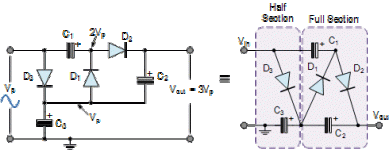Yep. It would be a voltage tripler! Grabbed from the web:
View attachment 2570657
That half-wave tripler would draw DC current from the input, which could then saturate whatever transformer is supplying the 400/230V
AC . And so a full wave version would need to be used.
A problem with voltage multipliers is that all of the output current is supplied by means of the charging and discharging of capacitors. And so you're going to need big capacitors to supply the required 100A, and they will be undergoing reasonably high stress. I suspect that there will also be relatively large harmonic currents drawn on the supply side of a voltage multiplier.
By using a transformer to boost the voltage followed by a 3-phase rectifier bridge, capacitors would just be needed to filter the ~13% ripple of a 6-pulse rectifier to the extent required.
The L-L voltage from the transformer can be used to drive the rectifier without causing a significant AC common-mode voltage on the DC output by leaving the secondary of the transformer floating, and then grounding one side of the rectifier's DC output. The isolation provided by the transformer allows this, and it should have other benefits as well.
Switching supplies could be used to boost the voltage, using transformers and/or inductors which would be relatively small because the switching frequency is significantly higher than 60 Hz. I'm not sure if there is something commercially available like this that would fit your needs.

